In Part Two of the Tim Mountford story we heard how he received his first professional contract from track promoter Oscar Daemers for a sprint series event on the famous Kuipke boards in Gent, through many kermis and road and track races, to landing a contract with Peter Post and his TI Raleigh squad, eventually retiring and setting up a bike shop business. However, in this Part Three of Tim’s interview, we roll back a couple of years to find out more about his experiences behind the ‘big motors’…
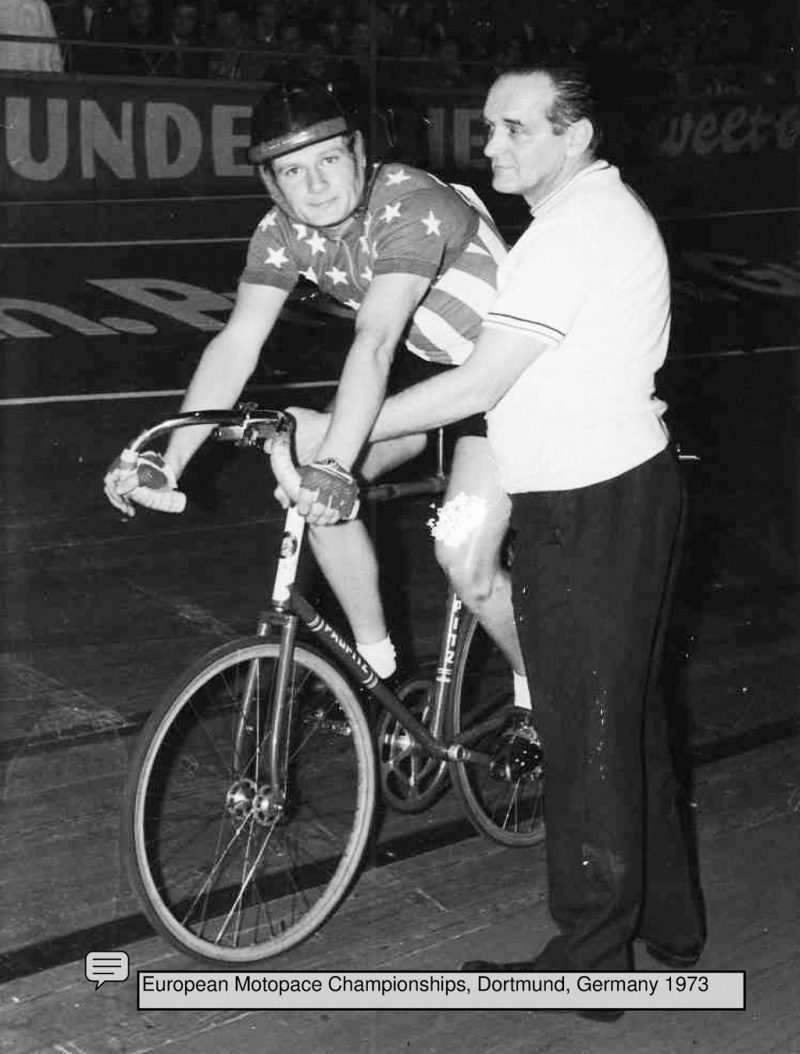
The big motors – how did you get into that? A long ways from sprinting…
“By my second inter season in ’72-‘73 my Stars and Stripes American jersey was becoming a hot commodity with the promotors and I my agent Jan Dirksen was calling me almost every week.
“That winter I first heard of a possible stayer ride with Dutch pacer Bertus de Graaf from my friend and European Stayer Champ Dieter Kemper. I believe the idea started amongst the stayer drivers wanting to spice up the show.
“That winter I took fifth place in both the Euro Sprint and the Euro Stayer championships. In the finals of the Euro Stayer championships at Dortmund I was running in fourth place with my eye on Dutchman Piet de Wit who was holding in third.
“Verschueren and Kemper were racing for first and second at two laps ahead of Piet and myself. My pacer De Graaf agreed to take me to third place if my legs held up against de Wit and Stam… forty minutes into the race my legs were fine and Stam was a lap back in fifth – it was my “butt” that was killing me.
“My saddle was not a problem in the earlier qualifying race, but in the final race it proved to be unforgiving with the G force pressure in the turns of a 200 meter track at a high speed. The pain was so great that I raised my hand to signal to the judges that I had a mechanical and to my mechanic Charlie Ludiwick who knew to have a deflated front wheel in his hand to show the track judge so I wouldn’t get disqualified or lose a lap.
“I was off the bike too long, lost a lap, and finished behind Cees Stam in fifth place. Another opportunity slipped away.
“The following two years I rode many stayer races on both indoor and outdoor tracks in Holland, Belgium and Germany.
“A stayer contract paid more money than a sprint contract although I continued to receive sprint contracts even though crits and motor races were affecting my leg speed in the sprints.
“My most exciting stayer race was in the 1973 World Championships Revenge match behind the big 2200cc motors on the huge 500 meter track in Amsterdam.
“The speed and the sound from those motors is so exciting and dramatic. When passing another motor you can feel the heat on your legs and see the flames from the short 20 cm engine exhaust pipe.
“Although de Graaf and I gave it our best effort, pre-race publicity featured Cees Stam and Piet de Wit who had placed first and second in the Words in Spain a few weeks earlier.
“But the real race was between Kemper and Verschueren who were out for revenge because like myself did not ride the World’s in Spain due to a new UCI rule requiring that the pacer and rider be of the same country. I finished the Revenge match in fifth place, again.
“The worst stayer race I rode was just two hours before the start of the Dortmund Six Day race with five other stayer riders. I needed to perform well with my partner Piet de Wit in the Six that followed the stayer race an hour later, but we were the only team where both riders had to ride the opening thirty-minute stayer race for the spectators. We got more money, but our legs felt like rubber in the first chase of the Six and we finished two laps down the first night.
“Okay, the show must go on, but I was wondering when I was going to get my big break? Something always seemed to come up.”
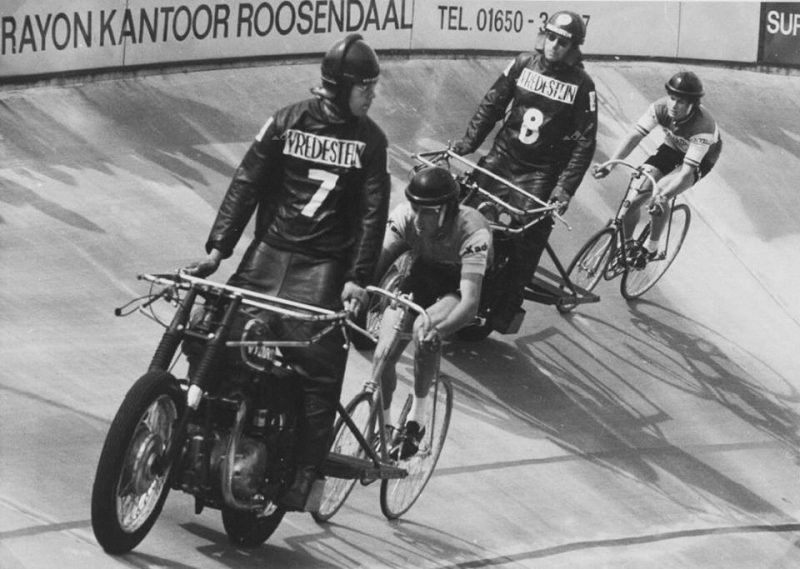
You rode criteriums too, tell us about them – how many seasons, your best results?
“I raced crits nearly every weekend during the summer in Holland and Belgium, a few in Germany, from 1970 to 1974.
“By my second season my new crit bike had a high bottom bracket for pedal clearance and I ran a 51-53 x 13-18 giving me a gear for any crit course and recovery when I needed it.
“Summer criteriums are an essential factor in preparing for the winter Six Day races and a chance for recognition.
“I wasn’t a crit specialist but my track experience enabled me to get into a good position during the final laps and I often placed in the top fifteen, plus winning a few prime sprint wins.
“My first pro crit was actually in England one week after the 1970 worlds in Leicester. Graeme Gilmore was also in the race after his ride in the world’s road race. I was first out of the final corner on the carriageway leading into the uphill sprint finish. The win was mine as no one in the peloton had an 11.2 sprint.
“Unfortunately, my plastic Simplex derailleur (Lejeune bike from the AVIS team in Paris that summer) slipped gears and I went from first to several places back in the final 200 meters.
“I enjoyed racing the pro crits and carpooling with Harry van Leeuwen (RIP) and a few other riders to kermises in Belgium.
“At the Belgium frontier we would check the newspaper for the best pro race that day without cobbles. It was like a job; get up and go to work with friends and the spectators and race ambiance were inspiring.
“The Ach van Chaam was the first invitational crit after the TDF and attracted a massive number of spectators.
“Many riders didn’t want someone like this American guy stealing the show and my name was often called out if they saw me moving up the peloton looking for a combine to tag onto in the final laps.”
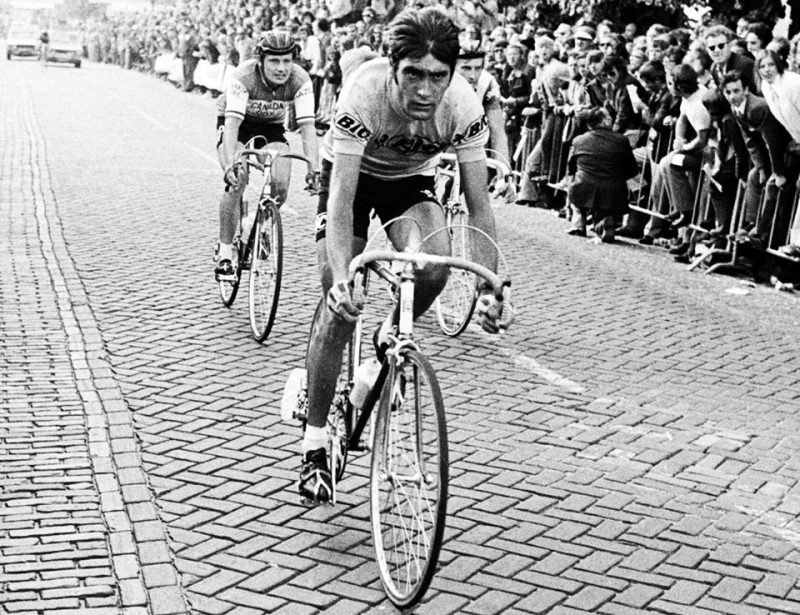
The Sixes, 16 rides between ’71 and ’74 – podiums in LA and Detroit and how about those Euro races and the mad lifestyle?
“Several weeks after working as a mechanic in the London Six I found myself racing in the second Six Day race I had ever seen in my life, the Antwerp Six. London being the first. And yet this was déjà vu for me.
“In my mind I felt at home as if I had been on this theatre stage before. The atmosphere, excitement and lifestyle of a Six Day race. Except that on the 250 meter Antwerp track with thirteen three man teams was like the Hollywood freeway during rush hour commute traffic.
“The high-speed chases with three man teams where you have to sprint to your partner was a little stressful at first.
“A couple of times our partner Willy Debosscher wasn’t moving fast enough for my exchange and I had to pass him by and make the exchange with our third man Jackie Simes.
“With an hour to go in the chase one night I remember Jackie saying “where the hell is Willy ?”
“Of course, Willy later became a showman and went on to ride one hundred forty-eight Six’s over the following sixteen years. After the race Jackie and I collected our contract and prime money and headed back home to Gent on a snowy night at 1 a.m.
“Six Day racing during the seventies were very popular throughout Europe with about thirteen races on the calendar every winter and there were no signs it would not continue.
“To make a living and continue on this Six Day winter circuit, or ‘road show’ as we say in Hollywood, I wanted to get a minimum of six contracts each winter starting in my third winter season, plus a few good partners. And without an American Six Day race promoter to exchange favourite rider contracts with other promoters I was on my own.
“So, I concluded that to get more contracts I would have to win a European or World championship or, as Graeme Gilmore did, ride my way to more contracts with my legs. And, of course, as I later learned Sercu would be the only sprinter with the ability to convert his legs to the Six’s and road classics.
“He was an exceptional athlete, RIP.”
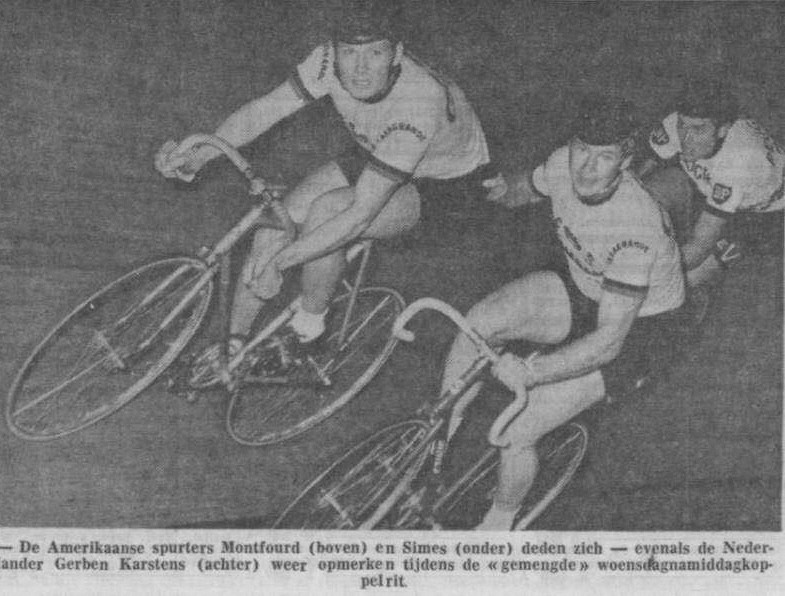
“I accomplished my goals of four contracts my second winter, and six contracts in my third season (1972-1973) including a second-place win in the Los Angeles Six with ace rider and good friend Dieter Kemper of Dortmund, losing to top Six Day team of Klaus Bugdahl and Graeme Gilmore.
“My fourth season the following winter (1973-1974) I was off to a good start with four Six Day contracts by mid-December.
“Paired with Six Day rider Albert Fritz of Bremen I won a third place in the Detroit Six.
“However, had I chosen Kemper again we would have won Detroit. Fritz was out of shape and wouldn’t ride for me, leaving me on my own to initiate any laps on the peloton.
“Later I won a fifth place in the Munster Six Day with Wolfgang Schultz of Berlin. I was riding well with German partners.
“By my fourth year I had competed in several European Championships in four different disciplines of sprint, omnium, Derny, and the big motors racing these events multiple times as well as placing well in two World Pro Sprint Championships.
“I was well known in the media especially in my home city of Rotterdam. I also had a studio in Dortmund to lessen the commute back to Rotterdam and therefore was labelled as a “Dortmunder” by the German media.
“It was a delightful feeling to have kids ask for my autograph while at the petrol station, or being the special guest at several night clubs. And the ladies; oh my god, to be an American bachelor in Europe competing in pro cycling was almost unmanageable, but of course, delightful if I may confess.
“I enjoyed hosting parties at my house with many international riders in town for an event at the Ahoy sports arena, and having friends on vacation from America and Australia.
“My dear English friend and fellow Rotterdam resident and Six Day rider Norman Hill of England married the Queen of the Groningen Six Day race. They have a daughter and I hope to visit them soon at their home in Vancouver, Canada.
“I have to admit that riding year-round in so many different events and driving all over Europe was taking a toll on my weight and upper body strength. I had lost nearly ten pounds. You need core strength to keep the legs going and not submit to fatigue.
“Poor morale can also break a rider’s character.
“This was the case for me after driving several hours to the Munich Six when I learned at track side an hour before the race start that I had been bumped from the race in favor of world motor pace champion Theo Verschuren. Theo had just recovered from a sickness the day before and motor pacing was very popular in Germany.
“After going nose to nose in the office with race director Rudi Altig for my contract money, my agent negotiated a double contract for me for the European Stayer Championships in Dortmund the following month and two more Six Day contracts, which I knew I was getting regardless.
“Although I was on track for receiving eight to ten Six contracts my fourth winter season this incident in Munich would play a role in my decision to retire and return to the States.”
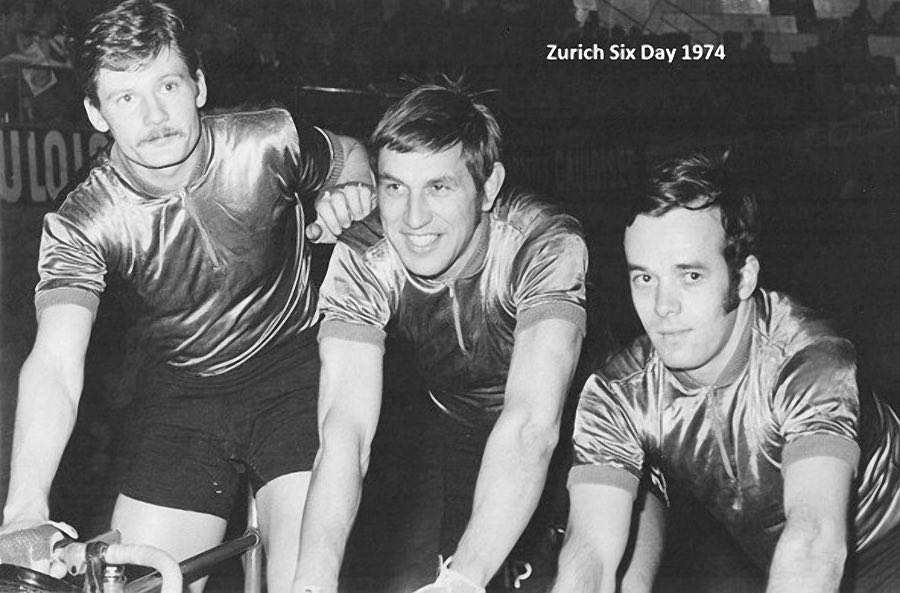
Catch Part Four of Tim’s story, about his time on the Six Day circuit, retirement and more!



